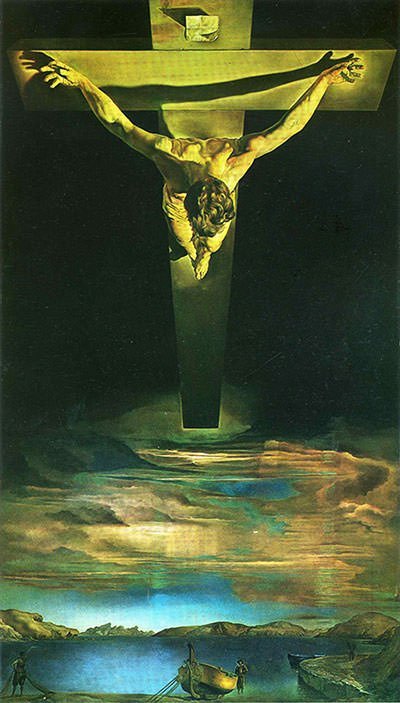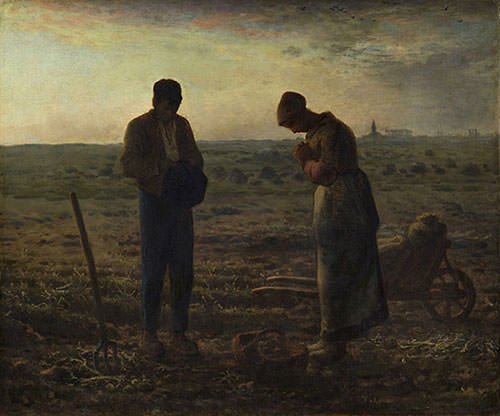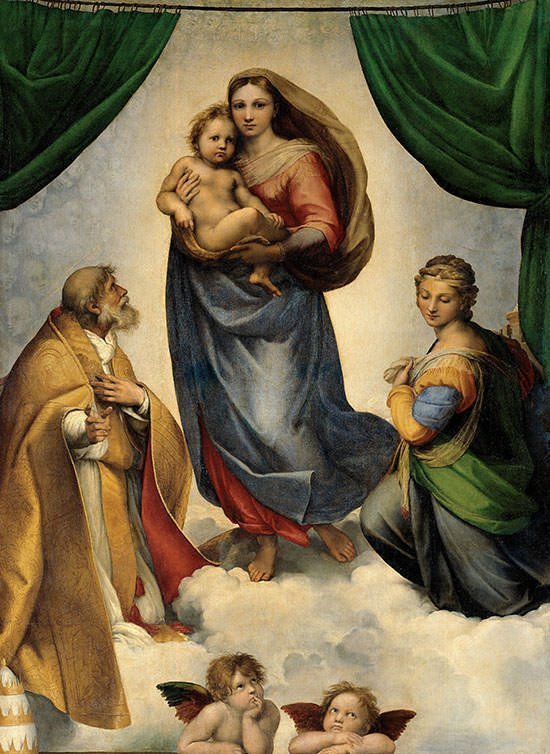Religious art uses religious themes and motifs usually having some recognizable moral narrative or attempting to induce strong spiritual emotions in the viewer. In the west, religious art may be defined as any artwork which has a Christian theme. Western religious painting is dominated by scenes from the Old Testament and from the life of Jesus Christ. Among the most commonly portrayed themes are depictions of Virgin Mary holding the infant Jesus and Christ on the cross. Many of the most famous religious paintings were created during the Renaissance, an influential cultural movement that originated in Italy. The three great masters of the Renaissance; Leonardo da Vinci, Michelangelo and Raphael; appear several times on this list. Here are the 10 most famous religious paintings including The Last Supper, Sistine Madonna, The Return of the Prodigal Son and The Creation of Adam.
#10 Transfiguration

| Location: | Pinacoteca Vaticana, Vatican City |
| Artist: | Raphael |
| Year: | 1520 |
Raphael was one of three great masters of High Renaissance art along with Michelangelo and Leonardo da Vinci. The Transfiguration is the last painting created by him. It is divided into two distinct parts. The upper half of the painting shows the transfiguration of Christ with the prophets Elijah and Moses on either side of him. In the lower portion, the Apostles are unsuccessfully trying to rid the possessed boy of demons. The upper portion also shows the transfigured Christ ridding the possessed boy from evil. The painting can be interpreted as depicting the contrast between god and man; with the upper part pure and symmetrical, and the lower part dark and chaotic. To Napoleon, Raphael was simply the greatest of Italian artists and The Transfiguration his greatest work while art historian Giorgio Vasari calls the painting Raphael’s “most beautiful and most divine” work.
#9 Christ of Saint John of the Cross

| Location: | Kelvingrove Art Gallery and Museum, Glasgow, Scotland |
| Artist: | Salvador Dali |
| Year: | 1951 |
This painting is known as Christ of Saint John of the Cross because its design is based on a drawing by the 16th-century Spanish friar John of the Cross. The composition consists of a triangle, which is formed by the arms of Christ and the horizontal of the cross; and a circle, which is formed by the head of Christ. The triangle might be seen as a reference to the Holy Trinity while the circle may represent unity, that is, all things exist in the three. Although the painting is a representation of crucifixion, it is devoid of nails and blood. According to Dali, the inspiration of the painting came to him through a cosmic dream, in which he was convinced that depiction of nails and blood would mar his portrayal of Christ. Christ of Saint John of the Cross was voted Scotland’s favorite painting in a 2006 poll. It is one of the most famous works of one of the leading modern artists; and is considered by many to be the greatest religious painting of the 20th century.
#8 The Angelus

| Location: | Musée d’Orsay, Paris, France |
| Artist: | Jean-Francois Millet |
| Year: | 1859 |
Jean-Francois Millet was one of the leading artists of the French Realism movement, which focused on portraying people and situations of the present with uncompromising accuracy. Millet is famous for his depictions of peasants. The Angelus is the last of his iconic trio of paintings after The Sower and The Gleaners. The Angelus is a catholic devotional prayer. This painting depicts two peasants bowing down to say the Angelus at the end of a day’s work. A church can be seen on the horizon and it is the ringing of the bell from the church that has led to the peasants stopping their work to say the prayer. The initial title of the work was “Prayer for the Potato Crop” as the scene depicted shows a potato field in Barbizon, France. The Angelus, a masterpiece of realism, was also one of the most widely reproduced religious paintings in 19th century France.
#7 The Burial of the Count of Orgaz

| Location: | Church of Santo Tomé, Toledo, Spain |
| Artist: | El Greco |
| Year: | 1588 |
Doménikos Theotokópoulos, commonly known as El Greco, was among the leading figures of the Spanish Renaissance who excelled as a painter of religious subjects but was also equally adept in portraiture and landscapes. This painting was commissioned to El Greco in 1586 by the parish priest of Santo Tomé in Toledo, Spain. It illustrates a popular local legend by which Saints Augustine and Stephen descended from the heavens to assist in the burial of Don Gonzalo Ruíz, a native of Toledo known for philanthropy and piety; and who was posthumously known as Count of Orgaz. The lower section of the painting depicts the miraculous burial while the above shows the spiritual world waiting to receive the pious man into heaven. As the artwork is a prime example of Mannerism, depicts a visionary experience and contains an impressive array of portraits, it is seen by art critics as the coming together of all extraordinary attributes of El Greco’s art. It is universally regarded as his greatest masterpiece and is perhaps the most famous religious painting of the Spanish Renaissance.
#6 Sistine Madonna

| Location: | Old Masters Gallery, Dresden, Germany |
| Artist: | Raphael |
| Year: | 1512 |
Raphael’s art is known for sweetness and clarity of form, serenity, harmony, perfection and visual brilliance. His popularity during his time was primarily due to the numerous pictures he painted of Madonna and Christ Child. Sistine Madonna depicts the Madonna holding the Christ Child; and flanked by Saint Sixtus and Saint Barbara. Also there are two winged cherubs beneath Mary who are perhaps the most famous cherubs depicted in any picture. Such is there popularity that there are many legends regarding how Raphael painted them and they have been reproduced on everything from paper table napkins to umbrellas. Sistine Madonna is considered one of the finest paintings by many notable critics and it is especially popular in Germany where it “has been hailed as ‘supreme among the world’s paintings’ and accorded the epithet ‘divine'”.
#5 The Last Judgment

| Location: | Sistine Chapel, Vatican City |
| Artist: | Michelangelo Buonarroti |
| Year: | 1541 |
Michelangelo exerted an unparalleled influence on the development of art in the west. He is widely considered the greatest sculptor ever and, though he had low opinion of painting, he is also regarded as one of the greatest painters. The Last Judgment is one of the most influential works in fresco in the history of Western art. Painted on the altar wall of the Sistine Chapel in Vatican City, it depicts the Second Coming of Christ (a future return of Jesus to earth) and the final and eternal judgment by God of all humanity. Jesus is shown in the center of the painting and is surrounded by prominent saints; while the Resurrection of the Dead and the Descent of the Damned into Hell is shown in the zone below. Though one of the most renowned religious paintings, The Last Judgment created much controversy. Among other things, Michelangelo was accused of mixing figures from pagan mythology into depiction of a Christian subject matter and for pursuing artistic effect over following the scriptural description of the event.
#4 The Calling of St Matthew

| Location: | San Luigi dei Francesi, Rome, Italy |
| Artist: | Caravaggio |
| Year: | 1600 |
Saint Matthew was one of the twelve apostles of Jesus and, according to Christian tradition, one of the four Evangelists. Matthew was initially a tax collector and Jesus Christ found him sitting at the tax collector’s booth. “Follow me”, Jesus told him, and Matthew got up and followed him. This painting depicts the moment at which Jesus inspires Matthew to follow him. Caravaggio is one of the most influential artists in European art history. Among other things; he painted from life, without drawings; and developed a technique called tenebrism, which was marked by the use of violent contrasts of light and dark. This helped him to create paintings with high drama and emotional intensity. The Calling of St Matthew was an immediate sensation when it was first displayed and it remains one of the most famous works by the artist.
#3 The Return of the Prodigal Son

| Location: | Hermitage Museum, Saint Petersburg, Russia |
| Artist: | Rembrandt van Rijn |
| Year: | 1669 |
In the Parable of the Prodigal Son, a father has two sons; the younger of whom asks for his inheritance, wastes his fortune and returns home after becoming destitute. He intends to beg his father to make him one of his servants but the father, instead, celebrates his return. When his elder son objects, the father tells him that they are celebrating because his brother, who had been lost, has now come to his senses. Rembrandt’s painting depicts the moment when the son returns home in a wretched state. The father can be seen receiving his son with a tender gesture while the brother crosses his hands in judgment. Rembrandt is renowned for the exceptional realism in his paintings due to his trademark light and shadow effects. Painted at the end of his career, the artwork demonstrates his mastery as he uses expressive lighting and coloring to brilliantly evoke in the viewer the parable’s message of forgiveness. The Return of the Prodigal Son is regarded by many critics as Rembrandt’s greatest masterpiece and a monumental achievement in Baroque art.
#2 The Last Supper

| Location: | Santa Maria delle Grazie, Milan, Italy |
| Artist: | Leonardo da Vinci |
| Year: | 1498 |
Leonardo da Vinci is now renowned as the prime example of the “Universal Genius” due to his accomplishments in a wide variety of fields. However for four centuries after his death, his fame rested primarily on his laurels as a painter. His most famous artistic achievement after the Mona Lisa, this painting represents the scene of The Last Supper of Jesus with his disciples. In it, Leonardo masterfully depicts the bewilderment and confusion that occurs among the disciples of Jesus when he announces that one of them would betray him. Leonardo’s detailed knowledge of anatomy, light, botany and geology; his interest in how humans register emotion in expression and gesture; and his subtle gradation of tone; all come together to make this painting among the most revered and famous religious paintings of all time. Some people believe that the person to the right of Jesus in the painting is not John the Apostle, but a woman named Mary Magdalene. This belief plays a central role in Dan Brown’s fiction novel The Da Vinci Code.
#1 The Creation of Adam

| Location: | Sistine Chapel, Vatican City |
| Artist: | Michelangelo Buonarroti |
| Year: | 1512 |
The work done by Michelangelo on the Sistine Chapel ceiling is a cornerstone of Renaissance art and The Creation of Adam is the most famous fresco panel of the masterpiece. The painting illustrates the Biblical creation narrative from the Book of Genesis in which God breathes life into Adam, the first man. God is depicted as an elderly white-bearded man wrapped in a swirling cloak while Adam, on the lower left, is completely nude. There has been much analysis of the painting and, among other things, it has been found that the shapes portrayed behind the figure of God are an anatomically accurate picture of the human brain; the red cloth around God has the shape of a human uterus; and the green scarf is thought to be a newly cut umbilical cord. The Creation of Adam is perhaps the best known painting after Mona Lisa; and along with The Last Supper, it is the most replicated religious painting of all time. The image of the near-touching hands of God and Adam has become iconic of humanity and has been imitated and parodied innumerable times.


What about ” Non mi tocare ” Jesus Christ Reserection
Thanks for all this information